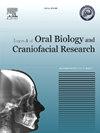评估炎症生物标志物作为种植体周围炎诊断工具的作用
Q1 Medicine
Journal of oral biology and craniofacial research
Pub Date : 2025-02-09
DOI:10.1016/j.jobcr.2025.01.015
引用次数: 0
摘要
大多数研究分析了龈沟液(GCF)中细胞因子在不同牙周病中的存在,但对种植周炎中龈沟液(PICF)的研究非常有限。目的探讨白细胞介素(IL)-1β和白细胞介素(IL)-6水平在种植体周围炎中的诊断价值。材料和方法共有40名患者参加了这项研究,每名患者至少有一颗种植牙。记录每个种植体周围和离种植体最近的牙齿的临床参数。收集龈沟液(GCF)/种植体周围沟液(PICF),评估IL - 1β和IL - 6的浓度。对种植体周围炎患者进行保守治疗,治疗3个月后记录患者临床参数、IL-1β、IL-6水平,并与治疗前比较。结果种植周炎组改良菌斑指数(MPI)、改良出血指数(MBI)、探测袋深度(PPD)等临床参数均高于健康种植体组和健康牙齿组,差异均有统计学意义。IL-1β和IL-6水平在种植周炎组也明显高于健康种植体和健康牙齿组。结论PICF生物标志物可作为一种诊断工具,补充种植体周围炎的诊断,并结合临床参数,使种植体周围炎的早期诊断成为可能。本文章由计算机程序翻译,如有差异,请以英文原文为准。

Evaluating the role of inflammatory biomarkers as a diagnostic tool in peri-implantitis
Background
Most studies have analyzed the presence of cytokines in Gingival crevicular fluid (GCF) in different periodontal diseases, but very limited studies have been conducted on Peri-implant crevicular fluid (PICF) in peri-implantitis.
Aim
The present study was conceptualized to explore the levels of Interleukin (IL)-1β and Interleukin (IL)-6 as a diagnostic marker in peri-implantitis.
Materials and methods
A total of 40 patients each having at least one dental implant were enrolled in the study. Clinical parameters were recorded around each implant and tooth nearest to it. Gingival crevicular fluid (GCF)/Peri-implant crevicular fluid (PICF) was collected to evaluate the concentration of IL‐1β and IL‐6. Conservative treatment was performed in peri-implantitis cases, 3 months after treatment their clinical parameters, IL-1β and IL-6 levels were recorded and compared with their pre-treatment values.
Results
Clinical parameters like Modified Plaque Index (MPI), Modified Bleeding Index (MBI) and Probing Pocket Depth (PPD) were statistically significantly higher in the peri-implantitis group as compared to the healthy implant group and healthy teeth group. IL-1β and IL-6 levels were also statistically significantly higher in the peri-implantitis group in comparison to healthy implants and healthy teeth group.
Conclusion
The study concludes that biomarkers in PICF can be used as a diagnostic tool to supplement the diagnosis of peri-implantitis along with the use of clinical parameters to make an early diagnosis of peri-implantitis possible.
求助全文
通过发布文献求助,成功后即可免费获取论文全文。
去求助
来源期刊

Journal of oral biology and craniofacial research
Medicine-Otorhinolaryngology
CiteScore
4.90
自引率
0.00%
发文量
133
审稿时长
167 days
期刊介绍:
Journal of Oral Biology and Craniofacial Research (JOBCR)is the official journal of the Craniofacial Research Foundation (CRF). The journal aims to provide a common platform for both clinical and translational research and to promote interdisciplinary sciences in craniofacial region. JOBCR publishes content that includes diseases, injuries and defects in the head, neck, face, jaws and the hard and soft tissues of the mouth and jaws and face region; diagnosis and medical management of diseases specific to the orofacial tissues and of oral manifestations of systemic diseases; studies on identifying populations at risk of oral disease or in need of specific care, and comparing regional, environmental, social, and access similarities and differences in dental care between populations; diseases of the mouth and related structures like salivary glands, temporomandibular joints, facial muscles and perioral skin; biomedical engineering, tissue engineering and stem cells. The journal publishes reviews, commentaries, peer-reviewed original research articles, short communication, and case reports.
 求助内容:
求助内容: 应助结果提醒方式:
应助结果提醒方式:


